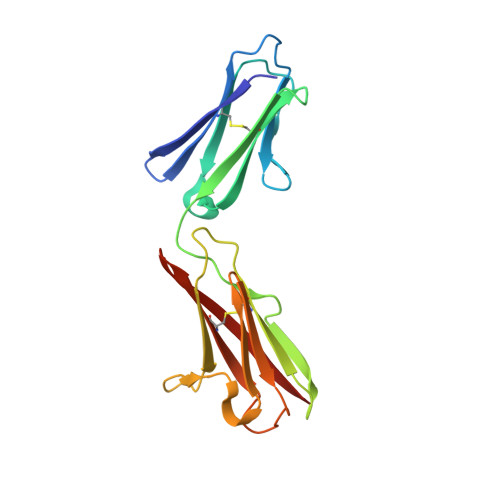Crystal structure of HAb18G/CD147: implications for immunoglobulin superfamily homophilic adhesion.
Yu, X.L., Hu, T., Du, J.M., Ding, J.P., Yang, X.M., Zhang, J., Yang, B., Shen, X., Zhang, Z., Zhong, W.D., Wen, N., Jiang, H., Zhu, P., Chen, Z.N.(2008) J Biol Chem 283: 18056-18065
- PubMed: 18430721
- DOI: https://doi.org/10.1074/jbc.M802694200
- Primary Citation of Related Structures:
3B5H - PubMed Abstract:
CD147, a member of the immunoglobulin superfamily (IgSF), plays fundamental roles in intercellular interactions in numerous pathological and physiological processes. Importantly, our previous studies have demonstrated that HAb18G/CD147 is a novel hepatocellular carcinoma (HCC)-associated antigen, and HAb18G/CD147 stimulates adjacent fibroblasts and HCC cells to produce elevated levels of several matrix metalloproteinases, facilitating invasion and metastasis of HCC cells. In addition, HAb18G/CD147 has also been shown to be a novel universal cancer biomarker for diagnosis and prognostic assessment of a wide range of cancers. However, the structural basis underlying the multifunctional character of CD147 remains unresolved. We report here the crystal structure of the extracellular portion of HAb18G/CD147 at 2.8A resolution. The structure comprises an N-terminal IgC2 domain and a C-terminal IgI domain, which are connected by a 5-residue flexible linker. This unique C2-I domain organization is distinct from those of other IgSF members. Four homophilic dimers exist in the crystal and adopt C2-C2 and C2-I dimerization rather than V-V dimerization commonly found in other IgSF members. This type of homophilic association thus presents a novel model for homophilic interaction between C2 domains of IgSF members. Moreover, the crystal structure of HAb18G/CD147 provides a good structural explanation for the established multifunction of CD147 mediated by homo/hetero-oligomerizations and should represent a general architecture of other CD147 family members.
Organizational Affiliation:
Cell Engineering Research Center & Department of Cell Biology, State Key Laboratory of Cancer Biology, Xijing Hospital, the Fourth Military Medical University, Xi'an, China.















